In this post, you will learn what is Screw Thread? Screw thread terminology, and types of screw threads.
What is a Screw Thread?
A screw thread may be considered as an advanced form known as a helix. Or A screw thread is a ridge wrapped around a cylinder or cone in the form of a helix, with the straight threads and later known as tapered threads.
The thread can be external, such as on a bolt or screw, or internal, such as inside a nut. A screw thread is the essential feature of the screw as a simple machine and also as a fastener.
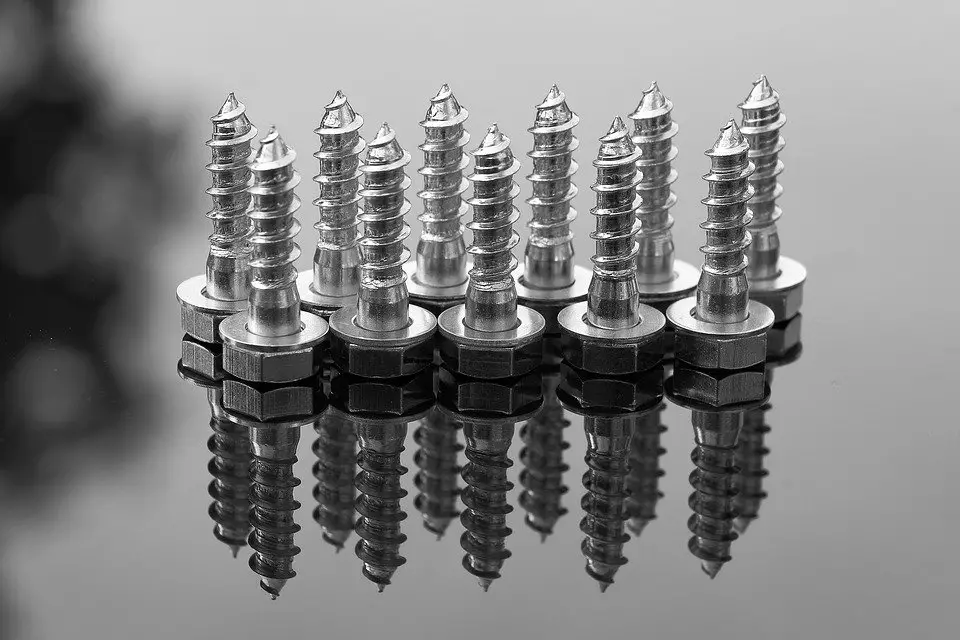
Fasteners means,
In all kinds of joining, the various parts are held together by devices known as fastening, and the elements by which the parts are so joined are called fasteners or fastening elements.
Read Also: Understand The Different Types of Springs & Their Applications
Types of Fastening
There are two types of fastening used in engineering practice:
- Temporary fastening
- Permanent fastening
Temporary fastenings are those in which repeated assembly or disassembly. It is possible without injury or damage to the fastener or to the part. In temporary fastenings, the parts are held together by fasteners such as screws, bolts, nuts, keys, cotter, pins, etc.
Threads are applied to many devices for various purposes some are as follows:
- To convey materials as in a gravity conveyor.
- To transmit power,
- It increases the efficiency of the applied effort as in an auto-jack.
- To control movement as in a micrometer.
- To hold parts together as in the case of fastening.
Read also: Different Types of Bearing and Their Uses [Complete Guide]
Screw Thread Terminology
Following are the terms used screw thread terminology:
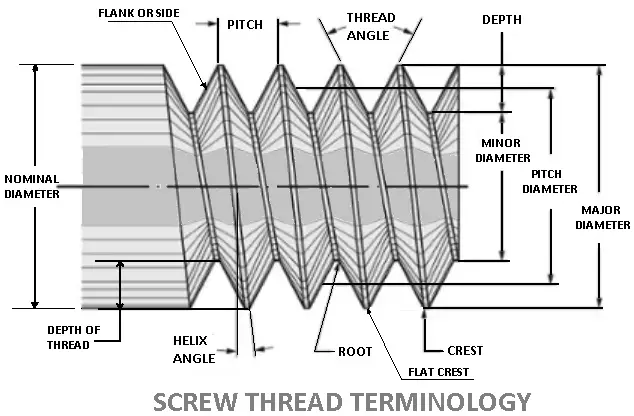
The following definitions refer to the various term used in screw threads. The various elements of a screw thread are shown in Fig. The external thread is the thread cut on the outer surface of a rod. The internal thread cut on the inner surface of a hole.
- Root
- Crest
- Flank or side
- The angle of the thread
- The depth of the thread
- Nominal diameter
- Major diameter
- Minor, core, or root diameter
- Pitch diameter
- Pitch
- Lead
#1 Root
It is the bottom portion of the surface of a thread, either flat or rounded which joins the sides of the adjacent threads.
#2 Crest
It is the top portion of the surface of a thread, either flat or rounded which joins the sides of the same threads.
#3 Flank or Side
It is the surface of a thread that connects the crest with the root and also it offers surface contact with its counterpart.
#4 The Angle of The Thread
It is the angle included between the sides of the two adjacent threads and measured on an axial plane.
#5 The Depth of The Thread
It is the distance between the crest and the root of a thread which is measured normally to the axis on an axial plane. It is designated as h3.
#6 Nominal Diameter
It is the diameter of the cylindrical rod on which the threads are cut. This diameter specifies the size of the screw.
#7 Major Diameter
It is the diameter of an imaginary coaxial cylinder that bounds the crest of an external thread or the roots of an internal thread.
D and d denote the major diameters of the internal and external threads respectively.
#8 Minor, or Core, or Root Diameter
It is the diameter of an imaginary coaxial cylinder that bounds the roots of an external thread or the crests of an internal thread.
- D1 and d3 denote the minor diameters of the internal and external threads respectively.
#9 Pitch Diameter
It is the diameter of the thread at which an imaginary coaxial cylinder that can be passed so as to cut the thread so that the width will be equal to the width of the groove.
- D2 and d2 denote the pitch diameters of internal and external threads respectively.
#10 Pitch
It is the distance from a point on a screw thread to the corresponding point on the next thread, measured parallel to the axis. It may be indicated as the distance from crest to crest, or from root to root, but the former is the convention.
#11 Lead
It is the axial distance advanced by a nut for its one full turn over a threaded rod. On a single start thread, the lead and the pitch are identical.
On a double start thread, the lead is twice the pitch, and on a triple start thread, the lead is three times the pitch. Thus, the lead may also be defined as the product of the pitch and the number of starts.
Read Also: What is a Sunk Key? Definition, Function, Types, Advantages
Types Of Screw Threads
The profile of a screw thread is based on whether it functions as a fastening device or a power transmission element.
The profile is triangular, known as V thread in the former, and square or its modifications in the latter. thus the two basic profiles or types of screw threads are (i) thread and (ii) Square thread.
#1 V Thread
The Bureau of Indian Standards has adopted the V-thread profile recommended by the International Organisation for Standards, ISO, a metric screw thread for use in our country.
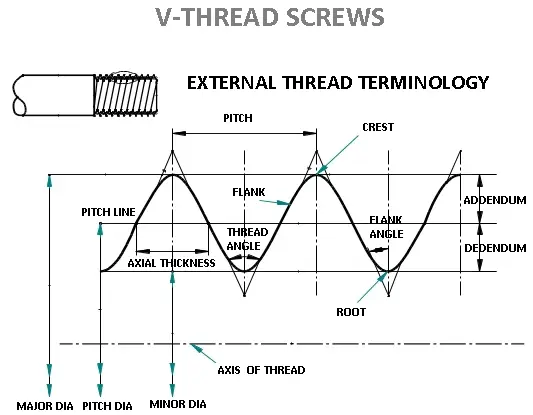
This type of screw thread is also known as Unified Thread. It has a 60° thread angle. The profile of this thread with standard proportions is shown in Fig. The dimensions of the internal thread are slightly different from that of the external thread.
#2 Square Thread
Since these types of screw threads are in the form of a square, it is called a Square thread. The flanks or the sides of this thread are perpendicular to the axis of the thread. The depth and thickness of the thread are equal to half the pitch.
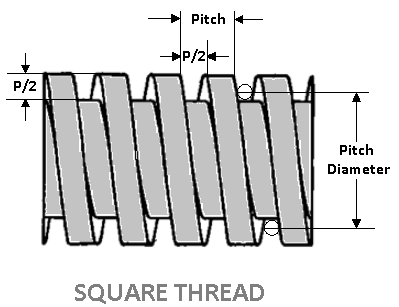
Since the root and crests of the square threads are 90° sharp corners they are likely to work quickly when pit is used. hence the crests and roots are modified in the actual threads.
The square thread is quite square in section. It is used for the transmission of motion and power as in vices, clamps, etc. And for converting a rapid rotary motion into slow linear motion, for example, the lead screw of a lathe, screw presses, jacks, etc,
There is less friction and fewer wear threads of this form, but they are more expensive to cut on a lathe.
#3 Acme Thread
This thread is the modified form of a square thread. Unlike the square thread, it is easier to cut and stronger at the root.
The angle of the thread is 29°. The inclined sides of the thread facilitate quick and easy engagement and disengagement, for example, the split out of the lead screw of a lathe.
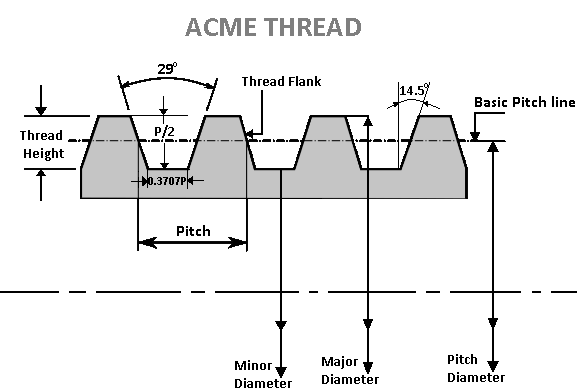
It is suitably used for power screws like the breaks screw, jack screws, and on the value operating screw for axial power transmission. The section of this thread with standard proportions is shown in Fig.
The acme thread is a modification of the square thread but it is easier to cut and stronger than square thread.
They are extensively used for the transmission of motion and power. The shape of this thread facilitates the use of engaging the split nut as in the lead screw of a screw-cutting lathe.
#4 Single and Multi-Threads
In a piece of work, it is possible to have several separate and independent threads running along with it. Accordingly, there are single-threaded screws and multiple or multi-start threaded screws.
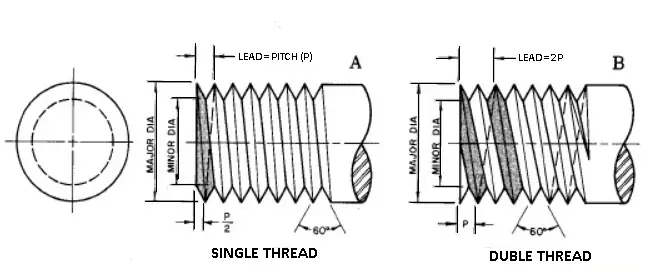
The independent threads are called starts, and we may have single-start, two-start, three-start, etc.
For one complete turn around the screw or bolt then there is a movement of one thread the screw is called a single-threaded screw. And when there is a movement of more than one thread, the screw is called multiple or multi-start threaded screws.
In the case of a three-start thread, for one complete turn, the thread advances three times as far as if it were a single thread. Multi-start threads are used in cases where rapid movement or motion is needed, and where they are widely employed.
#5 Right-hand and Left-hand Threads
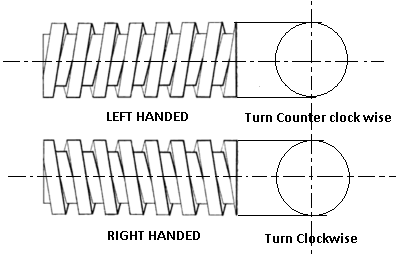
Screw threads may be made either right or left-handed. A right-hand thread is one in which the nut must be turned in a right-handed direction to screw it on, and a left-hand thread is one in which the nut would be screwed by turning it to the left. The figure illustrates these examples.
Download Pdf of this article
Conclusion
So now, we hope that we have clear all your doubts about Screw Thread Terminology. If you have still any doubts about the “Types of Screw Threads” you can contact us or ask in the comments.
That’s it thanks for reading. If you like our article then please share it with your friends. If you have any questions about any topic you can ask in the comment section.
Subscribe to our newsletter to get notified when we upload new posts.
Read More On Our Blog:
- Different Types of Gears and Their Applications [PDF]
- Definition of Mechanical Properties in Mechanical Engineers
- What is a Knuckle Joint? Diagram, Parts, Working, Applications
External Link: List_of_screw_drives, and screw heads styles.
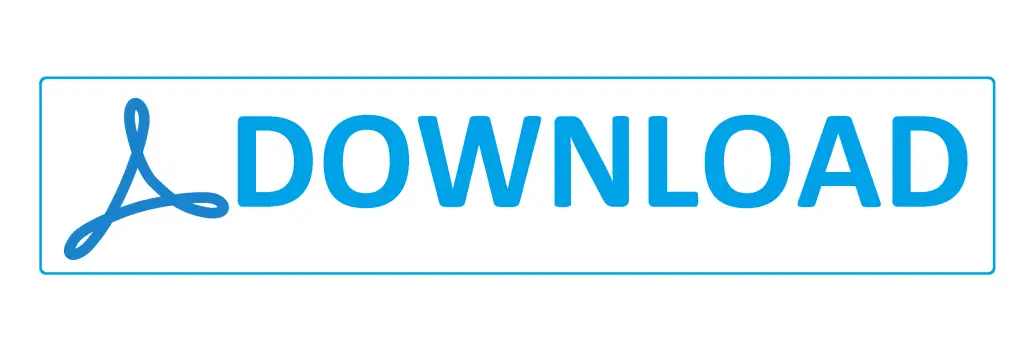
Thank you very informative and concise
You’re welcome.
Thanks for the post
It’s educating for both the young and old.
It wasn’t easy for me but because of this post it became easy
It’s Helpful. thanks once again thanks
I’m glad it was helpful for you. You’re welcome.
IT WAS VERY HELPFUL THANKS
AND IT WAS GOOD THERE WAS A DOWNLOAD BUTTON
You’re welcome 🙂 And every article has a download button.